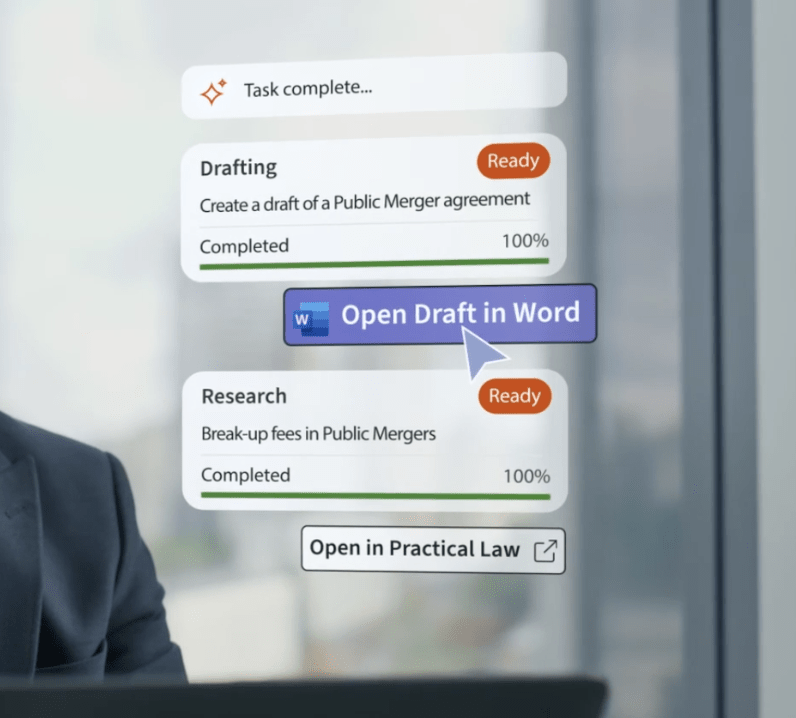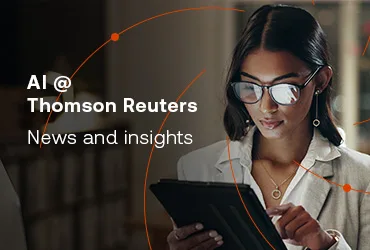The first part in this series identified many use cases for legal technology in the legal work that constitutes the core of a lawyer's expertise: research, drafting, evidence management, and more. Part three dives into legal tech for marketing.
There are many critical tasks related to the functions and operations of a legal organization that can be enhanced by today’s technology, making processes more efficient and legal practice more profitable.
These include collaboration, document automation, contract review, and due diligence. The common denominator in these tasks is that they depend heavily on sound data and process management.
Jump to ↓
| Collaboration |
| Drafting |
| Document automation |
| Contract review |
| M&A transaction management |
| Fund formation |
Read our blog series on a lawyer’s guide to legal tech: Buyer’s guide for legal research and other core tasks Read blog → |
Collaboration
Legal work does not occur in isolation. Lawyers constantly interact with clients, colleagues, courts, government agencies, and authorities. Removing friction from some of those collaborative relationships is one of the areas where legal tech can have its most significant impact.
No relationship is more important to a lawyer than the relationship with a client. Clients have come to expect the same level of communication and transparency from their law firms as they enjoy from other business entities they deal with. Legal tech can empower lawyers to meet these expectations, providing clients with frictionless communications with the lawyers working on their cases and self-serve access to important documents, timelines, and actions taken in their legal matters.

Law firm checklist: Client portals
Make client collaboration your competitive differentiator.
Access checklist ↗Tools that can enhance client relationships include client portals, internal portals focused on specific matters, and virtual deal rooms for transactions. These tools improve client responsiveness and ensure the utmost security and confidentiality of client information, surpassing the security of older methods of communication.
Clients are expecting more and more collaboration with their law firms. See how you can keep up with this transformation.
Drafting
In the fast-paced world of legal practice, time is a precious commodity. Legal professionals often find themselves spending a significant portion of their day — reportedly between 40 and 60% — drafting and reviewing documents. This repetitive and time-consuming task can detract from higher-value, strategic work that could better serve their clients and grow their practice.
Drafting technology is revolutionizing how these tasks are managed. By leveraging generative AI (GenAI), these tools can automate tasks from the creation and modification of document clauses to accessing a repository of proven documents and tailoring them to meet specific needs. In turn, legal organizations can have access to the most effective and relevant language (without starting from scratch) all while ensuring compliance and accuracy.
Ultimately, law firms that embrace these technological tools can find themselves at a competitive advantage, able to deliver faster, more accurate legal services that meet the evolving demands of their clients.
For a full guide on how drafting tools can transform your workflow, see the white paper, AI-powered legal drafting: The definitive guide for legal professionals.
Document automation
Creating accurate and effective legal documents is a core legal function. However, the process of creating those documents includes many repetitive steps and phases that can be augmented with technology.
Document automation consists of software, templates, and standardized clauses and language that can dramatically reduce the human effort, time, and costs involved in document drafting.
Today’s document automation systems handle all phases of document creation, including:
- Finding and applying the correct templates
- Integrating all data variables
- Enabling data entry with questionnaires and legal guidance
- Generating complete sets of finished documents, ready for review and delivery
Creating legal documents combines pure process work and the lawyer’s high-level judgment and experience. Automation balances those aspects by bringing speed and efficiency to routine document creation while leaving lawyers with more time for more analytical, creative, and consultative legal work where they can provide greater value to clients. It also reduces risk by eliminating errors and ensuring adherence to firm standards.
For a detailed guide to all that documentation automation entails and how to get started, see the white paper, Document automation for law firms: The definitive guide.
Contract review
One of the areas of legal practice where artificial intelligence (AI) has made the greatest inroads is contract review. In M&A work, for example, the due diligence process often includes a large-scale review of the target company’s contracts. Buyers and their counsel must identify any risks, opportunities, and obligations in those contracts. Manually scanning hundreds or thousands of contracts for the contract terms that might be relevant has become a Herculean task in large transactions – and is fraught with the risk of human error.
In recent years, however, AI techniques have been put to use in automating the extraction of the critical clauses that might contain risks and obligations – clauses like termination clauses, indemnity clauses, force majeure, etc. Using AI built on large language models (LLMs), contract review software has become the faster and more accurate approach to understanding the terms contained in sets of contracts, at a fraction of the cost of manual review. The software can make an accurate first pass at parsing the contents of the contracts, leaving lawyers with more time for the higher-value tasks of interpreting and analyzing the significance of the clauses.
M&A due diligence is not the only use case for AI-based contract review software. Real estate, where portfolios of leases need to be understood and managed, is another. Corporations increasingly use data extracted from contracts with AI to populate their internal contract management systems.
Generative AI (GenAI) will also shape the future of contract review software as more products use AI to extract data from contracts and summarize and communicate its analysis in increasingly actionable summaries and reports.
For a summary of the benefits, risks, and criteria for choosing contract review software, see BUYER’S GUIDE: Artificial intelligence in contract review software.
M&A transaction management
M&A practice is, perhaps more than any other type of legal practice, heavily process-driven. Each deal consists of a well-established order of operations that is very similar from deal to deal, even if every transaction has unique features.
Every deal includes a setup phase, the creation of transaction documents, due diligence, various regulatory filings and approvals, closing documents and signatures, and a post-closing phase with plans and commitments in place.
Technology has enhanced the ability of lawyers to manage these transaction stages and the ability of all stakeholders to maintain visibility into the entire chain of events. That includes allocating team resources, communicating with clients and counterparties, and taking action where risks are identified. The contract review software mentioned above is one of the core areas where technology has deeply enhanced the speed and quality of transactional processes.
Until recently, however, the technology supporting transactional practice was fragmented. A 2022 customer survey by Thomson Reuters indicated that many firms juggle between 5 – 10 technology systems to manage a single deal.
What’s new today is the emergence of comprehensive transaction management platforms that merge multiple point solutions into a single transaction environment. The benefits are significant. For clients, this entails a more transparent understanding of the status of their deals. For deal lawyers, it means eliminating friction, with less time spent jumping between applications. For firm management, it means better security and better visibility into project status and profitability.
Learn more about the benefits of an end-to-end transaction management platform.
Fund formation
Technology also supports law firms that want to support private equity and venture capital funds. Many firms prioritize gaining more business and wallet share from those clients and helping them at the fund formation stage is a high-value service.
The nice thing about this use case is that, for many firms, the technology for supporting those clients in the fund formation stage is already in place. For example, a firm using HighQ already has much of the technology it needs to support clients through fund formation stages, such as investor onboarding and regulatory and risk evaluations, in a secure and seamless environment. Firms with HighQ in place can also leverage industry-standard templates from Practical Law to automate the intake process.
|
For a more detailed look at how technology can streamline fund formation, see Digital fund formation services: A future for law firms.
There’s a technology for every legal practice
As the above examples show, there are many ways that technology can support any legal practice. The key is to identify where friction and manual processes hinder legal workflows and find the best solutions to solve those problems. And measure, measure, measure: it’s important to understand metrics such as time spent, profitability, and quality measures to evaluate progress.











